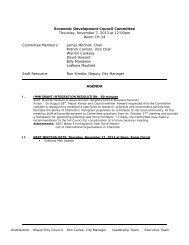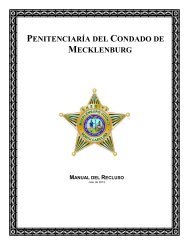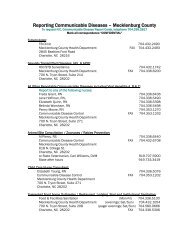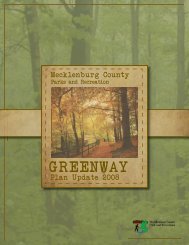ENVIRONMENTAL ASSESSMENT CHARLOTTE GATEWAY STATION
ENVIRONMENTAL ASSESSMENT CHARLOTTE GATEWAY STATION
ENVIRONMENTAL ASSESSMENT CHARLOTTE GATEWAY STATION
You also want an ePaper? Increase the reach of your titles
YUMPU automatically turns print PDFs into web optimized ePapers that Google loves.
Federal Funding: The CGS project has been the recipient of several federal grants<br />
appropriated or authorized by Congress under the Safe, Accountable, Flexible, Efficient<br />
Transportation Equity Act: A Legacy for Users (SAFETEA-LU) section 5309 Bus<br />
Discretionary program. This funding includes:<br />
FY 2005: $ 2,411,606 (FY 2005 Department of Transportation Appropriations)<br />
FY 2006-09: $ 19,864,800 (SAFETEA-LU)<br />
State Funding: NCDOT has invested $35 million to acquire the CGS site and adjacent<br />
property along the NS mainline tracks. By including this property as part of the Master Plan,<br />
NCDOT intends to leverage the value of the property to provide funding for the public<br />
transportation facilities included at CGS. If additional funding is required for those facilities<br />
and to relocate Amtrak to CGS, it will seek such funding through its usual state budget<br />
process.<br />
Charlotte Area Transit System: CATS’ contribution to the CGS project will be funded using<br />
revenues from the ½ cent sales and use tax dedicated to funding future transit<br />
improvements. Voters in Mecklenburg County approved the sales tax in November 1998<br />
and it has been collected since April 1999. By statute, revenues from the sales and use tax<br />
can only be applied to expenditures for planning, construction, and operation of a county<br />
wide public transportation system.<br />
A detailed funding plan, including the potential use of private capital, will be developed and<br />
implemented by CATS and NCDOT prior to the start of construction.<br />
S.9 Public and Agency Coordination<br />
A comprehensive public involvement plan was developed to parallel the North Corridor EA<br />
process in order to engage citizens in the project and ensure that the project reflected their<br />
input and concerns. This is consistent with the City of Charlotte and CATS policy of<br />
proactively seeking public comment on transit-related projects.<br />
The goals of the public involvement plan are to:<br />
• Inform/educate citizens in a factual and objective manner about the transit/land-use plan<br />
and its associated opportunities and challenges.<br />
• Proactively seek opinions, perceptions and participation from the North Corridor publics<br />
so that the EA phase recommendations may reflect the needs of the community<br />
• Document and incorporate public input into the North Corridor EA phase<br />
• Ensure that all public involvement activities identify and address the needs of area<br />
minority, low-income and transit dependent populations<br />
Stakeholders across Charlotte have participated in the activities and outreach leading to the<br />
2030 Transit Plan, which includes the CGS project. Stakeholders with specific interests in<br />
CGS – including residents, neighborhood associations, businesses and other interest<br />
groups – were specifically targeted and included as part of the public involvement process.<br />
Public outreach and design activities for CGS occurred in two phases. Between 2000 and<br />
2002, NCDOT undertook an extensive effort to determine the feasibility of building a<br />
Charlotte Gateway Station S-16 EA
















